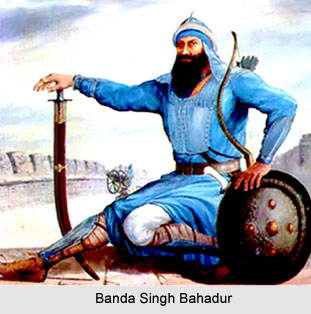 Banda Singh Bahadur, after being appointed by Guru Gobind Singh began studying the various aspects of the situation before waging war against the rulers of Sirhind. These rulers had carried out large scale atrocities on the Sikhs and executed the two younger sons of Guru Gobind Singh. Banda Bahadur once saved the villagers from dacoits and thus gained their confidence and support. He proclaimed that he would undertake to protect the poor and the helpless against all official tyrants. He also invited people to join the Khalsa brotherhood. He invited the Sikhs in Malwa, Doaba and the Majha districts of the Punjab calling upon them to join him in the war against the Mughals.
Banda Singh Bahadur, after being appointed by Guru Gobind Singh began studying the various aspects of the situation before waging war against the rulers of Sirhind. These rulers had carried out large scale atrocities on the Sikhs and executed the two younger sons of Guru Gobind Singh. Banda Bahadur once saved the villagers from dacoits and thus gained their confidence and support. He proclaimed that he would undertake to protect the poor and the helpless against all official tyrants. He also invited people to join the Khalsa brotherhood. He invited the Sikhs in Malwa, Doaba and the Majha districts of the Punjab calling upon them to join him in the war against the Mughals.
Sonepat
The first town he attacked was Sonepat. He gathered a small force of about 500 Sikhs. The faujdar of Sonepat was not fully prepared to defend themselves. Hence they lost and fled from the field. Banda Bahadur received information that a small Mughal military force was halting at village Bhuna, on their way to Delhi. He went and attacked them and soon overpowered them. He also won against another troops and took away all their horses and other weapons. The Sikhs were now preparing to attack Samana. The town was occupied by a number of `Sayyads` and `Mughal zamindars`. Jalal-ud-din, the executioner of Guru Tegh Bahadur, Shashal Begh and Bashal Begh, the executioners of young sons of Guru Gobind Singh also resided here.
Samna
The town of Samana was well fortified with a strong wall and every haveli (large house) was a fortress by itself. Banda Bahadur along with his force attacked the town in the morning of 26 November 1709. They entered it from all sides suddenly. The infuriated peasants of the neighbouring villages also joined the Sikhs to wreak vengeance on the much hated Mughals, and set their houses on fire. Before nightfall, the beautiful town of Samana, with its lofty buildings, was converted into a heap of ruins. Almost 10,000 soldiers of the Mughal Dynasty soldiers died in the war. In the war Banda Bahadur was greatly impressed by the bravery of Bhai Fateh Singh and appointed him as the faujdar of Samana. Wazir Khan of Sirhind was greatly alarmed at the Sikh invasions and had sent some spies to Samana to gather information. These spies were however caught and punished.
Ghuram
The Sikh army next attacked the town of Ghuram and over powered it and plundered the town. The next towns to be seized were Thanesar and Shahbad, inhabited by the Mughal Sayyads and Shaikhs. The town of Mustafabad was also looted by the Sikhs. The local faujdar had 2,000 imperial troops and two large guns. On seeing the Sikh army approaching the gangs of plunderers began following them. However, the Sikh army made a strong attack and soon won against them
Sadhaura
Banda Bahadur`s next expedition was against Sadhaura that was ruled by Usman Khan. He was known for his oppressing his subjects. He attacked the Sadhaura fort and defeated the Imperial army. They also captured the fort. Banda Bahadur made some entrenchments close to the town for use of his troops from where the Sikhs fought the Mughal army in 1710 and 1711. The advance of the Sikhs under Banda Singh Bahadur gave an opportunity to the oppressed peasants to seek revenge against Usman Khan and his officials. They joined hands with Banda Bahadur in looting and destroying the properties of the rich Sayyads and Sheikhs. A bloody battle ensued between the masses and the Sayyads and Sheikhs. The rich Sayyads and Sheikhs had hidden themselves in the haveli of Shah Badr-ud-din. They thought it to be a safe place for hiding. They were all located and put to death. Presently the haveli is called Qatal Garhi or slaughter house. Banda Bahadur next sent messages to a large number of Sikhs from Doaba and Majha to join him. Wazir Khan was greatly worried and he was devising plans to prevent the forces from joining each other.
He thus sent Sher Mohammad Khan of Maler Kotla along with his brother and cousins to check the movements of the Sikhs. The Majha troops which had reached Ropar were attacked by Sher Mohammad Khan with much greater force than that available with the Sikhs. The Sikhs were thus on the verge of loosing the war but on that night a new batch of Sikh volunteers from north-east came to join them. This doubled their force and courage. The imperial army was now no match for the Khalsa. Next day in the morning
Khizar Khan, brother of Sher Mohammad Khan, was shot dead by a bullet fired from the trenches. This created a lot of confusion amongst the Afghans. Next Sher Mohammad Khan came out to face the Sikhs but was easily defeated. Nashtar Khan and Wali Mohammad Khan were both killed in the scuffle and Sher Mohammad Khan was severely wounded. On one hand while the Mujhail Sikhs were fighting with the Afghans of Maler Kotla, Banda Bahadur marched upon Banur and occupied it. The Sikhs were very jubilant about their victory. Later Banda Bahadur`s army marched a few miles to receive the Sikh forces coming from the Ropar side.




















